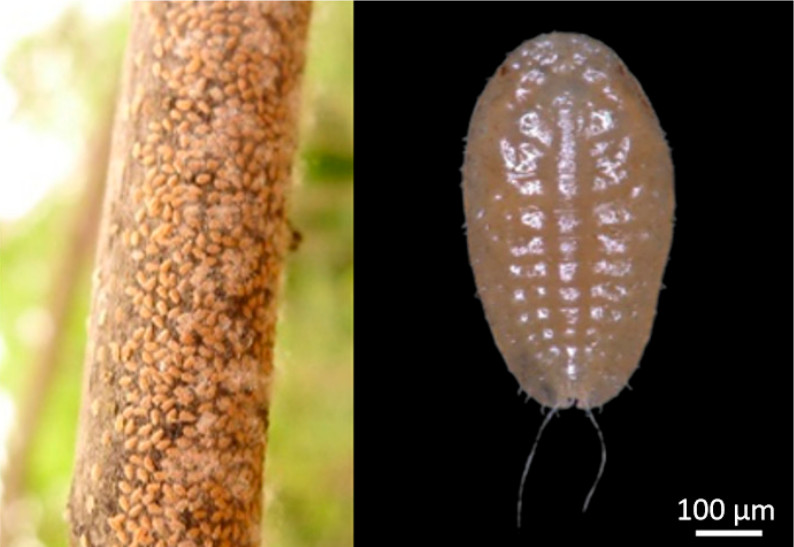Valid Names Results
Ericerus pela (Chavannes, 1847) (Coccidae: Ericerus)Nomenclatural History
- Coccus pela Chavannes 1847: 216. Type data: CHINA: Location and host plant of type material not indicated. Syntypes, unknown, accepted valid name Notes: Type material probably lost (Ben-Dov, 1993).
- Coccus sinensis Walker 1852: 1085. Type data: CHINA:. Syntypes, both sexes, Type depository: London: The Natural History Museum, England, UK; junior synonym (discovered by Green1904c, 374).
- Coccus cereus Walker 1852: 1087. replacement name that is unjustified (discovered by BenDov1993, 109).
- Coccus sinensis Westwood 1853: 95. Type data: CHINA: probably Shanghai, host plant of type material not indicated.. Syntypes, both sexes, Type depository: Oxford: Hope Entomological Collections, University Museum, England; junior synonym (discovered by Westwo1853a, 532). Notes: Unmounted syntypes are available at the Natural History Museum, Oxford, UK (Yair Ben-Dov, visit at OXUM, on December 15, 2002).
- Ericerus ceriferus; Guérin-Méneville 1858: lxvii. misidentification
- Pela cerifera Targioni Tozzetti 1866: 140. replacement name that is unjustified (discovered by BenDov1993, 109).
- Ericerus pela; Signoret 1869c: 102. subsequent use Notes: Incorrect citation of "Westwood" as author.
- Eulecanium potanini Borchsenius 1955a: 297. Type data: CHINA: Sinan Province, on undetermined plant.. Syntypes, female, Type depository: St. Petersburg: Zoological Museum, Academy of Science, Russia; junior synonym (discovered by Danzig1967, 167).
- Ericerus pe-la (Chavannes, 1847); Wu 2001b: 256. misspelling of species epithet
Common Names
- China wax scale insect BenDov1993
- china wax scale insect BenDov1993
- Chinese scale BenDov1993
- chinese scale BenDov1993
- pela scale BenDov1993
Ecological Associates
Hosts:
Families: 1 | Genera: 4
- Oleaceae
- Chionanthus | Kuwana1923b
- Fraxinus | Danzig1967 Ali1971 Ferris1950a Hodgso1994a
- Fraxinus bungeana | Kuwana1907 Kuwana1923b
- Fraxinus chinensis | ChenHeWa2015 Danzig1967 | ssp. rhynchophylla (= Fraxinus rhynchophylla)
- Fraxinus longicuspis | Kuwana1923b
- Fraxinus mandshurica | Danzig1967
- Ligustrum | Ali1971 Ferris1950a Kuwana1923b
- Ligustrum ibota | Kuwana1902 Kuwana1907 TakahaTa1956
- Ligustrum japonicum | TakahaTa1956
- Ligustrum lucidum | ChenHeWa2015 Rathou1880
- Ligustrum obtusifolium | Suh2020
- Ligustrum sinense | Rathou1880
- Syringa reticulata | Danzig1967 | ssp. amurensis (= Syringa amurensis)
Foes:
Families: 2 | Genera: 3
- Davidiellaceae
- Cladosporium | LiuYuZh2022 | (endosymbiont) (pathogen)
- Encyrtidae
- Metaphycus dispar | GuerriNo2000
- Metaphycus ericeri | WangChCh2011
- Microterys ericeri | Suh2019b WangChCh2011
- Microterys sinicus | WangChCh2011
Associates:
Families: 3 | Genera: 3
- Rhizobiales | QiLiZh2025
- Methylobacteriaceae
- Methylobacterium | QiLiZh2025
- Ophiocordycipitaceae
- Ophiocordyceps | QiLiZh2025
- Ophiocordyceps sinensis | QiLiZh2025
- Ophiocordycipitaceae | DengYuWa2021
Geographic Distribution
Countries: 5
- Brazil | Chavan1848
- China | DeLott1971 Green1904b Hodgso1994a
- Guangxi (=Kwangsi) | ChenHeWa2015
- Guizhou (=Kweichow) | ChenHeWa2015
- Hunan | HuHeWa1992
- Shanxi (=Shansi) | ChenHeWa2015
- Sichuan (=Szechwan) | Ali1971
- Xizang (=Tibet) | Westwo1853
- Yunnan | Ali1971 ZhangYaMi1986
- Zhejiang (=Chekiang) | Wu2001b
- Japan | Kuwana1917
- Russia
- Primor'ye Kray | BenDov1993
- South Korea | ESKSAE1994 ParkMaYo1998
Keys
- Hodgso2020: pp.221-223 ( Adult (M) ) [Coccidae species]
- Borchs1957: pp.389 ( Adult (F) ) [Palaearctic region]
Remarks
- Systematics: Subfamily: Eulecaniinae (Choi & Lee, 2019) For details about the date of publication of the type species, see De Lotto (1971)
- Structure: See colour photograph in Kawai (1980, Figs. 6.55, a,b). The differences in wax glands and wax secretion between females and males reflect their different needs for living habitats and different ecological strategies. Sciophilous male nymphs are with five types of wax glands, and the wax glands on the dorsum secrete a layer of wax filaments plausibly for protection against direct light irradiation. On the other hand, five types of wax glands were found on the abdomen of females. Heliophilous female nymphs hardly secrete any wax, but the wax glands located along the spiracle on the abdomen may help this insect to breathe. Female adults secrete wax filaments on eggs to protect them from predators and prevent themselves from sticking to each other. Males appear to secrete wax for creating a shaded niche that fits their sciophilous life style, whereas females are likely to adopt an ecological strategy with thickened epidermis for heliophilous acclimatization and overwintering. (Qi, et al., 2019)
- Biology: A biparental species, which develops one annual generation in Japan (Kuwana, 1923b), Russia, Vladivostok region (Danzig, 1965, 1967, 1980b) and in China (Li, 1985). The annual life cycle described by Danzig (1980b). The main ecological characteristics for suitable growth areas of E. pela are described as annual average temperatures of between 11° and 16°C, light 1900 to 2500 h/a (hours per year), rainfall 800 to 1200 mm, and annual relative humidity between 65 and 75% (Chen et al., 2007). The distribution area exhibits different climate conditions, with the highest temperate being 44°C in the summer in Chongqing city and the lowest temperature being below −30°C in the winter in Changchun city. E. pela can establish populations and survive and reproduce normally in these conditions. This insect can survive the extremely low winter temperatures in Northeast China and can resist the drastic decrease in temperature in autumn and winter. (Zhang, et al., 2021)
- Economic Importance: A comprehensive account on the life history and commercial breeding was presented by Li (1985). The wax secreted by the male nymphs is harvested in China and processed to produce the China wax, a commodity of considerable economic value in China (Li, 1985; Qin, 1997).
- General Remarks: Good description and illustration of the adult female have been given by Danzig (1980b), Tang (1991) and by Hodgson (1994a). Good description of the adult female given by Borchsenius (1957).
Illustrations
Citations
- Ali1971: distribution, host, illustration, taxonomy, 32
- AnYuWe2023: genetic structure, genetics,
- BecchiNiDi2024: evolution, genetics, genome, phylogeny,
- BenDov1993: catalog, 109-110
- Blanch1883: chemistry, economic importance, 239-248
- Borchs1955a: description, distribution, host, taxonomy, 297-298
- Borchs1957: description, distribution, host, taxonomy, 392-394
- CamachCh2015: distribution, host, natural enemies, 8, 14
- CenJi1988: biological control, distribution, economic importance, host, life history, 230-232
- Chavan1847: taxonomy, 216
- Chavan1848: description, distribution, host, taxonomy, 145
- ChenHeWa2015: DNA, genetic structure, 17820-17827
- ChenLuCh2021: DNA sequencing, genetic structure, morphology, structure,
- Cheng1974: distribution, economic importance, host, life history, 376-384
- ChoiLe2019: phylogeny, taxonomy, wax secretion, 402, 404
- Cocker1896b: distribution, 331
- Danzig1965: description, distribution, ecology, economic importance, host, illustration, life history, taxonomy, 537-544
- Danzig1967: description, distribution, economic importance, host, illustration, life history, taxonomy, 167-169
- Danzig1980b: description, distribution, host, illustration, life history, taxonomy, 285-289
- Danzig1995: taxonomy, 19
- DeLott1971: description, distribution, taxonomy, 146-147
- DengWeMa2025: evolution, genome, phylogeny, 3, 16
- DengYuWa2021: illustration, symbionts, 4
- DiSoraTuBr2023: phylogeny, 7, 8
- DingLiLu2022: genetic structure, wax,
- ESKSAE1994: distribution, list, 112
- FengChCh2001: chemistry, economic importance, 322-327
- FengChHe2006: genetics, physiology, 284-288
- FengChMa2006: chemistry, economic importance, 1
- FengChYe1999: chemistry, economic importance, 515-518
- Fernal1903b: catalog, 146-147
- Ferris1950a: description, distribution, host, illustration, taxonomy, 72-73,85-87
- FuShYu2024: DNA, wax secretion,
- Giliom1967: description, distribution, host, illustration, taxonomy, 67-70
- Green1904b: description, distribution, taxonomy, 374-375
- Guerin1858: taxonomy, LXVII
- HeOh1998: chemistry, economic importance, 22-25
- Hodgso1994a: description, distribution, host, illustration, taxonomy, 235-237
- Hodgso2020: key, 223
- HouWeZh2023: phylogeny, 343, 344, 346
- HuChYa2018: biology, chemistry, economic importance, 1-11
- HuHeWa1992: description, distribution, host, taxonomy, 186
- JiaoZh2000: biological control, 291-296
- Kawai1972: description, distribution, host, taxonomy, 11-12
- Kawai1980: distribution, host, taxonomy, 165-166
- KondoWa2022: distribution, host, list, 10
- KozarWa1985: catalog, distribution, 77
- Kuwana1902: distribution, host, taxonomy, 62
- Kuwana1907: distribution, host, taxonomy, 190
- Kuwana1917: distribution, host, taxonomy, 61-64
- Kuwana1923a: biological control, distribution, host, life history, taxonomy, 393-403
- Li1985: economic importance, life history, taxonomy, 26-33
- LiesenMaDe2025: molecular biology, 5
- LiuNiLu2022: phylogenetics,
- LiuWaLi2019: genetic structure, life cycle, male, reproduction,
- LiuYuZh2022: entomopathogenic fungi, symbiont,
- LiuZhXu2023: economic importance,
- LuHuDe2023: DNA, phylogenetics,
- MaChZh1995: distribution, host, 117-119
- MongueMaGr2024: evolution, genome, karyotype,
- MongueWoMa2025: evolution, genome, male, reproduction, 7-8, 12-13
- Paik1978: distribution, host,
- QiLiZh2025: bacteria, biology, endosymbiont, evolution, illustration, wax,
- QiLvCh2019: evolution, wax glands, wax secretion,
- QinWaLi2025: genome, 2
- Rathou1880: biology, description, description of male, diagnosis, distribution, illustration, morphology, natural enemies, taxonomy, 41-55
- Shinji1935b: distribution, host, 768
- Signor1869: catalog, distribution, host, taxonomy, 848,864,872
- Signor1874: description, distribution, host, taxonomy, 91-92
- SongWaTa2024: economic importance, phylogeny, 1, 4, 8-9
- Suh2019b: natural enemies, 4
- Suh2020: distribution, host, 11
- Takaha1929: distribution, host, 68
- Takaha1955f: distribution, host, 240
- TakahaTa1956: distribution, host, 7
- Tang1977: description, distribution, host, illustration, taxonomy, 90-91
- Tang1984b: distribution, host, 127
- Tang1991: description, distribution, host, illustration, taxonomy, 153-154
- Tao1999: distribution, host, taxonomy, 56
- Targio1866: taxonomy, 140,141
- Walker1852: distribution, host, taxonomy, 1085,1087
- Wang1980: description, distribution, host, illustration, taxonomy, 50-51
- Wang1981TC: distribution, host, 289
- WangChWa2003: life history, parthenogenesis, 386-390
- WangWaYe2005: ecology, life history, physiology, 421-424
- WangXu2006: chemical control, distribution, host, 152-154
- WardOnBo2024: phylogenetics, 4
- Westwo1853: description, distribution, host, taxonomy, 95
- Westwo1853a: description, distribution, host, taxonomy, 532
- Willia2017a: catalog, list of species, 212
- WilliaBe2009: catalog, taxonomy, 15,36,43,44
- Wu2001b: distribution, 256
- XieXuZh2004a: chemistry, 512-518
- XieXuZh2006a: chemistry, morphology, wax secretion, 21-202
- Yang1982: description, distribution, host, illustration, taxonomy, 170,171-174,179
- YangYuHa2019: DNA, DNA sequencing, evolution, phylogenetics,
- YangZhGo2012: chemistry, economic importance, life history, molecular data, 1-10
- YasumaNa1957: ecology, life history, 203-219
- YeZhLi2025: DNA, genome, phylogeny, 6, 10
- ZhangJiXi2025: evolution, genome, phylogeny, 5
- ZhangLiAn2021: biological control, genetic structure, physiology,
- ZhangYaMi1986: distribution, host, 108-109
- ZhangYaMi1987: distribution, host, 283-285
- ZhaoLiJi2001: chemistry, economic importance, 216-218
- ZhaoLiLi2001: chemistry, 603-612
- ZhaoLiYa2001: chemistry, life history, 456-459
- ZhaoShYa2002: chemistry, life history, 318-322
- ZhaoWaWa2004: biological control, distribution, ecology, host, life history, 746-750
- ZhaoWaYe2003: biological control, distribution, host, 32-38
- ZhaoWeLi2025: DNA, evolution, genome, molecular biology, phylogeny,
- ZhaoYuZh2019: chemistry, honeydew, illustration,
- ZhaoZhYa2001: chemistry, 257-262



